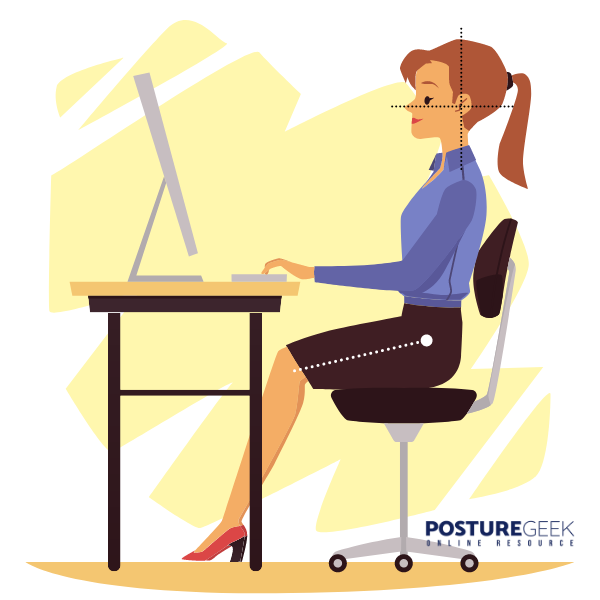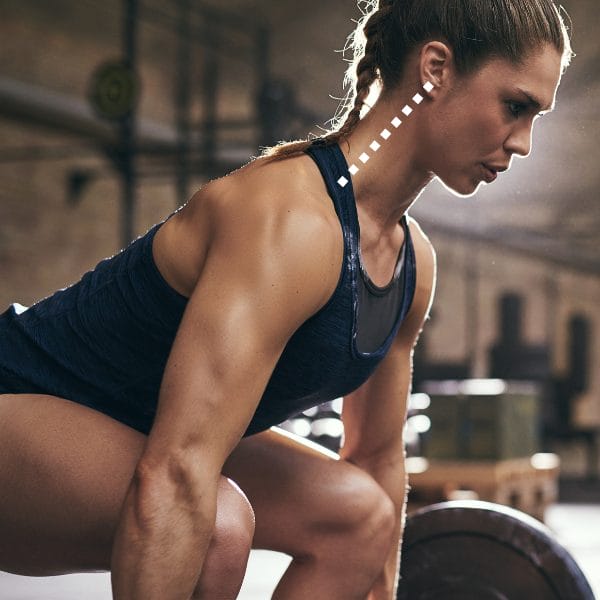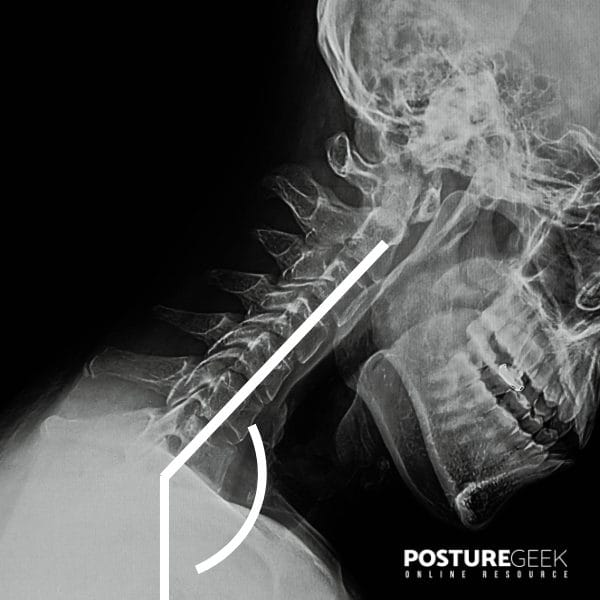Correct Neck Posture: the importance of head and neck position.
- Updated - January 21, 2025
Correct neck posture is an often overlooked but essential aspect of maintaining good posture.
PostureGeek.com Tweet

Correct neck posture is an often overlooked but essential aspect of maintaining good posture. The position of your head and neck can significantly impact the alignment of your spine and pelvis and your body’s overall balance. Maintaining proper posture can prevent neck strain and forward head posture, which are common issues due to modern lifestyle habits.
When your head and neck align, your muscles can work more efficiently, reducing joint strain and helping prevent pain. Specific stretches can help relieve neck, upper back, and shoulder tension, promoting relaxation and reducing discomfort.
Your posture is how you hold your body upright against gravity.
A sign of good posture is when your body is trained to stand, sit, lay down, and move in ways that put the least strain on supporting muscles and ligaments when you’re moving or bearing weight.
Maintaining good posture helps you to:
- Prevent pain in your neck, shoulders, and back
- Reduce the risk of injury
- Prevent Joint pain
- Breathe more easily
- Increase your energy levels
- Look taller and more confident
Your head and neck position can affect your posture.
Your head and neck position plays a significant role in your overall posture. For example, if your head protrudes forward or is constantly tilted to the side, it can pull your shoulders and back out of alignment, causing you to slouch.
Likewise, spending a lot of time looking down at your phone or computer screen can strain the muscles and ligaments in your neck, shoulders, and back, leading to poor posture. This strain can affect you throughout the day, disrupting the natural balance between your head and shoulders.
The notion of good posture requires the balanced and aligned relationships of five distinct landmarks:
- Ear
- Shoulder
- Hip Joint
- Knee
- Ankle
Position indicates the alignment - what is the correct neck position?
Good posture is essential for overall health and well-being. By improving your head and neck position, you can help improve your posture and reduce pain.
PostureGeek.com Tweet

The neutral position of the head on the neck is when your ears are in line with your shoulders. When your head is in this position, it places the least strain on your muscles and ligaments.
The neck must be equally distant from both the body’s sides and the front and rear. A vertically stacked body can only be created by a vertical cervical spine. It will provide comfort, minimizing any neck or shoulder-related problems.
By finding a balance between these landmarks and a plumb (straight) line, you are actively working toward symmetry and, more importantly, allowing the body to work with gravity. More importantly, any movement away from the balance between these points (landmarks) at any one or more junctions will lead to imbalance and dis-ease.
Here are some tips on how you can improve your head and neck position to help improve your posture:
- Keep your chin level with your horizon. This will help keep your head from tilting forward or to the side.
- Don’t look down at your phone or computer screen for long periods. Instead, take breaks often to give your neck and back a break from the strain.
- Sit up tall with your shoulders back and down. This will help keep your spine in alignment and prevent slouching.
- Strengthen your back and neck muscles with exercises like rows, chin-ups, and shoulder shrugs. This will help support good posture and prevent pain.
- Stretch your chest muscles and front of your shoulders with stretches like doorway chest stretches and overhead arm stretches. This will help reduce tightness in the muscles that can pull your shoulders and head forward.
- Incorporate chin tucks into your routine. This exercise helps strengthen neck muscles and promotes better head alignment, countering issues like forward head posture and tech neck.
Good posture is essential for overall health and well-being. By improving your head and neck position, you can help improve your posture and reduce pain.
Discover a practitioner near you.
Looking for a practitioner near you? Our extensive network of qualified professionals is here to help you.
Key Four Muscles in Head Movement.

Four important superficial muscles that move the head are:
- Sternocleidomastoid muscle – This muscle runs from the Sternum and Clavicle to the base of the skull and is responsible for turning the head.
- Trapezius – This muscle runs from the base of the skull to the middle of the back. It is responsible for, among other things, shrugging the shoulders.
- Levator scapulae – This muscle runs from the neck to the shoulder blade and is responsible for lifting the shoulder blade.
- Splenius muscles- These muscles run from the base of the skull to the middle of the back and are responsible for extending and rotating the head.

These muscles allow you to move your head in different directions, such as nodding, shaking, and turning. By keeping these muscles strong and flexible, you can help reduce the strain on your neck and improve your posture. Neck flexion, which involves bending the head forward, is also crucial for relieving tension in the neck and upper back muscles.
However, these muscles must only be allowed to take over some activity. The intrinsic (smaller muscles closer to the spine) are essential in maintaining healthy movement and stability of the neck.
When problems arise in the head, neck, and shoulders, these muscles can often play ‘second fiddle’ to the neck’s more significant and grosser moving superficial muscles.
Support dictates functionality
The overarching truth is that the level of support impacts the structures above. This can be clearly seen when considering the head and neck. A balanced and stable neck is relative to the stability and health of the shoulder girdle. For example, the shoulder blades must be able to move freely on the rib cage with the shoulders relaxed.
Your head should sit directly on top of your shoulders (think about a string running from the top of your head, through the center of your body, and down to the ground). Suppose your head is positioned even slightly forward. In that case, the weight of your head (averaging 10-12lbs) pulls on the muscles and ligaments in your neck and back, causing pain and tension. When these muscles and ligaments become overloaded and tight, it can lead to poor posture.
Additionally, when the arm and shoulder are restricted function of the head and neck can be compromised. This can lead to an increased likelihood of neck pain.
Neck Pain: Forward head posture and text neck

One of the most common posture-related problems is forward head posture, leading to a condition called text neck. To address this, it is crucial to fix forward head posture through targeted exercises and strategies.
Forward head posture occurs when your head is positioned too far forward on your shoulders. This puts extra strain on the muscles and ligaments in your neck and back and can cause pain and tension.
Tech neck is a condition that arises from spending too much time looking down at your phone or computer screen. This can cause the muscles and ligaments in your neck to become overloaded and tight, leading to poor posture and pain.
Understanding how to sit at your workstation can assist you in improving forward head posture.
The human body is designed to move.

When movement is limited, so is the range of motion in the joints. When the range of motion is limited, so is the ability to maintain a healthy posture. A sedentary lifestyle can result in shortened muscles, which pull on the bones and joints, leading to poor posture, particularly in the upper back.
The good news is that there is always time to improve your posture. By strengthening the muscles in your back and shoulders and stretching the muscles in your chest, you can help pull your shoulders back and stand taller.
Additionally, improving your flexibility can help reduce the strain on your muscles and joints, making it easier to maintain good posture.
8 tips to help improve your posture:
Many factors can affect posture, but you can make significant improvements with a few mindful adjustments. These simple tips can help you feel more aligned, reduce discomfort, and boost your confidence.
Stand Tall and Feel Aligned
Visualize a string gently pulling you upward from the top of your head, helping your body feel light and balanced. Relax your shoulders, lightly engage your stomach, and avoid locking your knees. If you’re standing for a long time, shift your weight occasionally to stay comfortable.
Sit with Comfort and Support
When sitting, focus on keeping your back straight, and your shoulders relaxed. Adjust your chair so your hips are slightly higher than your knees, and ensure your feet are flat on the floor. Taking regular breaks every 20 minutes to stretch or move around can work wonders.
Lift with Care
Protect your back by bending your knees and keeping your back straight when lifting. Let your leg muscles do most of the work, and hold the object close to your body. Avoid twisting while lifting to prevent strain.
Sleep in a Supportive Position
Choosing the correct sleeping position can help your spine stay aligned. Sleeping on your back or side is ideal, and a supportive pillow for your head and neck makes all the difference. Try to avoid sleeping on your stomach, as it can strain your spine.
Choose Shoes That Support You
Comfortable, well-fitting shoes with proper support can significantly benefit your posture. While high heels or tight shoes may look appealing, they can throw off your alignment over time. Opt for footwear that helps you feel balanced and supported.
Create an Ergonomic Work Setup
If you work at a desk or computer, ensure your screen is at eye level to reduce neck strain. Sit with your shoulders relaxed, elbows close to your body, and wrists aligned with your forearms. Remember to take regular breaks to move and stretch.
Stay Mindful of Your Posture While Moving
As you walk or stand, imagine yourself standing tall and balanced. Relax your shoulders, keep your chin level, and look ahead. Taking longer strides and gently swinging your arms can make movement feel more natural and comfortable.
Practice Awareness During Physical Activity
Whether exercising or playing sports, maintaining good posture helps prevent injuries. Warm up before you start, and focus on keeping your back straight and shoulders relaxed. Supportive footwear and stretching after your activity will also help maintain flexibility.
By incorporating these gentle habits into your day-to-day life, you’ll gradually improve your posture, feel more at ease, and reduce the risk of pain or injury. Small steps taken consistently can make a big difference!
Finally
The human body is designed to move. When movement is limited, so is the range of motion in the joints. When the range of motion is limited, so is the ability to maintain a healthy posture. A sedentary lifestyle can result in shortened muscles, which pull on the bones and joints, leading to poor posture.
However, the good news is that there is always time to correct neck posture. Even small changes can make a big difference. By strengthening the muscles in your back and shoulders and stretching the muscles in your chest, you can help pull your shoulders back and stand taller.
Additionally, improving your flexibility can help reduce the strain on your muscles and joints, making it easier to maintain correct neck posture. As with all things related to your health, it is important to seek the advice of your doctor or other recognized healthcare professional.
PLEASE NOTE
PostureGeek.com does not provide medical advice. This information is for educational purposes only and is not intended to be a substitute for professional medical attention. The information provided should not replace the advice and expertise of an accredited health care provider. Any inquiry into your care and any potential impact on your health and wellbeing should be directed to your health care provider. All information is for educational purposes only and is not intended to be a substitute for professional medical care or treatment.
About the author
Find Expert Posture Practitioner Near You
Discover our Posture Focused Practitioner Directory, tailored to connect you with local experts committed to Improving Balance, Reducing Pain, and Enhancing Mobility.
